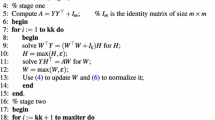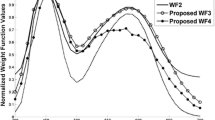Abstract
The positive basis functions of the reflectance spectra of Munsell color chips are extracted by using the classical nonnegative matrix factorization method. Different numbers of basis, i.e., 3 to 5, are determined and used as projection spaces. The spectral reflectances of samples are defined in the desired compact spectral spaces and the performances of the spaces are evaluated through the cost of the “lost data” by computing of the root mean square error between the actual and the reconstructed spectra as well as the corresponding color difference values under different viewing conditions. The method is also compared with the most welcomed technique, i.e., principal component analyzing, and its priority is shown to some extent in the three dimensional space. To show the importance of the spectral behaviors of samples in the dataset on the extracted basis and consequently the error of the spectral reconstruction trial, the adaptive non-negative matrix factorization method is introduced and examined in the reconstruction of spectral data from the colorimetric tristimulus values. The suggested method weights the samples in the database proportional to the colorimetric differences between the specimens in the dataset and the sample whose spectral has been aimed, prior to the extraction of all positive bases. The root mean square errors between the actual and the reconstructed spectra as well as the metamerism indices under A and F11 illuminants are calculated and the results show considerable improvement over the classic non-negative matrix factorization method as well as the principal component analyzing technique.
Similar content being viewed by others
References
L. T. Maloney: J. Opt. Soc. Am. A 3 (1986) 29.
J. Parkkinen, J. Halikainen, and T. Jaaskelainen: J. Opt. Soc. Am. A 6 (1989) 318.
D. H. Marimont and B. A. Wandell: J. Opt. Soc. Am. A 9 (1992) 1905.
M. D’Zmura and G. Iverson: J. Opt. Soc. Am. A 10 (1993) 2148.
J. Romero, A. Garcia-Beltran, and J. Hernandez-Andres: J. Opt. Soc. Am. A 14 (1997) 1007.
J. B. Cohen: Psychon. Sci. 1 (1964) 369.
H. S. Fairman and M. H. Brill: Color Res. Appl. 29 (2004) 104.
T. Jaaskelainen, J. Parkkinen, and S. Toyooka: J. Opt. Soc. Am. A 7 (1990) 725.
A. Garcia-Beltran, J. L. Nieves, J. Hernandez-Andres, and J. Romero: Color Res. Appl. 23 (1998) 39.
E. K. Oxtoby and D. H. Fosterô: Perception 34 (2005) 961.
R. Ramanath, R. G. Kuehni, W. E. Synder, and D. Hinks: Color. Res. Appl. 29 (2004) 29.
K. Ansari, S. H. Amirshahi, and S. Moradian: Color. Technol. 122 (2006) 128.
F. Ayala, J. F. Echavarri, and P. Renet: J. Opt. Soc. Am. A 23 (2006) 2020.
X. Zhang and H. Xu: J. Opt. Soc. Am. A 5 (2008) 371.
T. Harifi, S. H. Amirshahi, and F. Agahian: Opt. Rev. 15 (2008) 302.
H. Laamanen, T. Jaaskelainen, and J. P. S. Parkkinen: Proc. SPIE 2001 (4197) 367.
N. Eslahi, S. H. Amirshahi, and F. Agahian: Opt. Rev. 16 (2009) 296.
S. Westland and C. Ripamonti: Computational Colour Science Using Matlab (Wiley, Chichester, U.K., 2004) p. 176.
R. S. Berns: J. Soc. Dyers. Col. 110 (1994) 386.
Y. Sun, F. D. Fracchia, T. W. Calvert, and M. S. Drew: IEEE Comput. Graph. 19 (1999) 61.
N. Attarchi and S. H. Amirshahi: Color Res. Appl. 34 (2009) 26.
H. Shen, P. Cai, S. Shao, and J. Xin: Opt. Express 15 (2007) 15545.
D. D. Lee and N. S. Seung: Nature 401 (1999) 788.
G. Buchsbaum and O. Bloch: Vision Res. 42 (2002) 559.
F. Agahian, S. A. Amirshahi, and S. H. Amirshahi: Color Res. Appl. 33 (2008) 360.
V. Babaei, S. H. Amirshahi, and F. Agahian: to be published in Color Res. Appl.
University of Joensuu Color Group. Spectral Database [http://spectral.joensuu.fi/].
MATLAB Version 7.8 (Math Work Inc., 2009).
Author information
Authors and Affiliations
Corresponding author
Rights and permissions
About this article
Cite this article
Amirshahi, S.H., Amirhahi, S.A. Adaptive non-negative bases for reconstruction of spectral data from colorimetric information. OPT REV 17, 562–569 (2010). https://doi.org/10.1007/s10043-010-0101-9
Received:
Revised:
Accepted:
Published:
Issue Date:
DOI: https://doi.org/10.1007/s10043-010-0101-9




